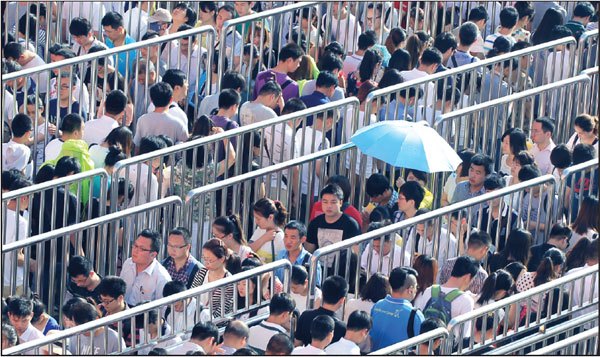
Commuters line up to enter the Tiantongyuan North Subway Station in Beijing at about 7:30 am. Located between the Fifth and Sixth Ring Roads, the station is crowded during the morning rush hour as local residents head to work downtown. (Zhu Xingxin / China Daily)
Poor infrastructure and a lack of facilities in many new suburban townships mean the nation's downtowns remain overcrowded. Wang Yanfei reports.
Experts are calling on the government to urgently to formulate solutions to urban planning problems, as concerns rise about the lack of infrastructure construction and policy support given to new suburban districts and townships.
Although people are being encouraged to relocate from the overcrowded downtowns, a lack of schools, hospitals and transportation systems in suburban areas mean many are reluctant to move.
The inefficient transportation network in some outlying areas of Beijing has prompted widespread criticism from residents, such as Lyu Ling, who lives in the eastern suburb of Beiqijia, between the capital's Fifth and Sixth Ring Roads, about 24 kilometers from the downtown.
Lyu said she is regularly late for appointments because the network is uncoordinated, so trains and buses rarely coincide.
"I have to walk 20 minutes to the nearest bus station and then spend 15 minutes getting to the nearest subway station," she said, "I often wonder if I am still living in Beijing - the capital seems far bigger than before."
The 23-year-old cited a recent incident where despite leaving home two hours before a scheduled meeting with friends in the Haidian district, she still arrived late.
Lyu's family bought the house in 2006, and in the following decade they witnessed how Beijing's massive urban sprawl - the construction of new towns near the periphery - has resulted in a range of problems.
"The area where my community stands was barren and underdeveloped 10 years ago," she said. "We bought the house because the district was expected to be developed extensively in the future and we thought it would be a good investment."
The developer promised that the district would eventually have convenient transportation and entertainment facilities, but "the CEO of the real estate firm committed suicide a couple of years ago. I guess it was because residential property prices failed to surge as high as he expected and he couldn't repay the debt."
Real estate agent Lin Chaoxin said property prices haven't risen exorbitantly in Beiqijia compared with the "scary price surge in Beijing's core areas", a reference to the soaring prices within the Fifth Ring.
Pilot towns
In the early 1990s, the National Development and Reform Commission chose Beiqijia as one of a number of pilot towns for the capital's urban expansion plan.
In 2006, a revised municipal development plan handed the district the "key task" job of developing itself into an innovative hi-tech industrial development zone for information technology, biotechnology and high-end equipment manufacturing.
Although a number of State-owned companies moved to Beiqijia in 2009, the area still lacks basic infrastructure and remains, in Lyu's view, a "sleepy town".
Many similar small and medium-sized new towns and cities are being built across China, each with a different key task assigned by the central government.
By the end of May, 3,500 new towns and cities had been built nationwide, according to the NDRC's annual New Town and New City Development report.
The massive urban expansion is the result of the national plan to relocate 100 million rural residents to urban regions by the end of 2020, a key task in the 13th Five-Year Plan (2016-20).
Inefficient land use
The problems resulting from urban sprawl have loomed large in recent years, according to Joanna Masic, a senior urban development specialist at the World Bank.
"Without a sustainable long-term plan, urban sprawl has led to massively inefficient land use and real estate development," she said, adding that the requisition of rural land for industrial use has been particularly inefficient because it has largely been driven by administrative decisions not market demand.
Data from the Beijing Municipal Institute of City Planning and Design show that in the Beijing suburb of Yizhuang, industrial land use accounts for a large proportion of the government's urban development plan, while the development of public facilities accounts for a much smaller slice.


















































